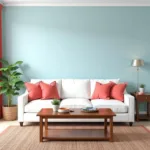What colors catch the eye? It’s a question that artists, designers, and marketers have pondered for centuries. From the vibrant hues of a tropical sunset to the subtle shades of a calming forest, color has the power to evoke emotions, attract attention, and even influence our decisions. Understanding the science and psychology behind color perception can unlock the secrets to creating visually stunning and impactful designs, whether you’re choosing paint for your living room or designing a marketing campaign.
The Science of Eye-Catching Colors
Our eyes are naturally drawn to contrast. High contrast combinations, such as black and white or complementary colors like blue and orange, create a visual “pop” that demands attention. This is because our visual system is wired to detect edges and differences in brightness, making these combinations instantly noticeable. But contrast isn’t the only factor. Saturation also plays a key role. Highly saturated colors appear more vibrant and intense, drawing the eye more readily than muted or pastel shades.
However, highly saturated colors can be overwhelming if used excessively. Balance is crucial. Pairing a vibrant color with a neutral or less saturated shade can create a harmonious and eye-catching effect. For example, a bright red accent wall can be balanced with softer beige or gray tones in the rest of the room.
Psychological Impact of Color
Different colors evoke different emotions and associations. Red, for example, is often associated with passion, energy, and excitement, while blue is linked to calmness, trust, and stability. Understanding these psychological associations can help you choose colors that align with the desired mood or message you want to convey. Think about how certain brands utilize color to create a specific brand identity.
For instance, if you are wondering what colors go well with magenta, consider its boldness and pair it with complementary greens or analogous purples for a visually appealing look.
Using Color to Create Focal Points
What colors catch the eye can also be used strategically to create focal points within a space or design. A brightly colored piece of furniture, a bold accent wall, or a vibrant piece of artwork can draw the eye and create visual interest. This technique is often used in interior design to highlight specific features or create a sense of hierarchy within a room. For example, if you are unsure what colors match with blue clothes, try pairing them with complementary orange or analogous green accessories to make the blue pop. You can also learn how to invert colors on CapCut to create interesting visual effects.
Color Harmony and Balance
Creating eye-catching color combinations isn’t just about choosing bright or contrasting colors. It’s also about achieving a sense of harmony and balance. Using a color wheel can help you identify complementary, analogous, and triadic color schemes that create visually pleasing and balanced combinations. Understanding color theory can elevate your designs from simply eye-catching to truly stunning. Exploring what braces colors are there can also give you a better understanding of how different colors work together in a small space.
If you are looking for what colors go with light green clothes, you can explore a variety of options. Neutrals like white, beige, and gray create a clean and classic look. For a more vibrant approach, try pairing light green with shades of pink, coral, or even a deeper teal. These combinations offer a fresh and stylish take on your wardrobe.
“Color is a powerful tool,” says renowned color consultant, Amelia Hues. “It can transform a space, evoke emotions, and communicate a message. Understanding how to use color effectively is essential for anyone who wants to create visually impactful designs.”
Another expert, Dr. Chromatica Spectrum, adds, “The psychology of color is fascinating. By understanding how different colors affect our perception and emotions, we can use color to create spaces that are not only aesthetically pleasing but also psychologically beneficial.”
In conclusion, what colors catch the eye is a complex interplay of science, psychology, and artistic principles. By understanding the principles of contrast, saturation, color harmony, and the psychological impact of color, you can create designs that are both visually stunning and emotionally resonant.
FAQ
- What are complementary colors?
- How can I use color to create a focal point?
- What is the difference between saturation and brightness?
- How can I use a color wheel to create harmonious color schemes?
- What are some common color psychology associations?
- What are some examples of eye-catching color combinations in nature?
- How can I use color to create a specific mood in a room?
Need more help with your color choices? Contact us! Phone: 0373298888, Email: [email protected] Or visit us at: 86 Cầu Giấy, Hà Nội. We have a 24/7 customer service team.
